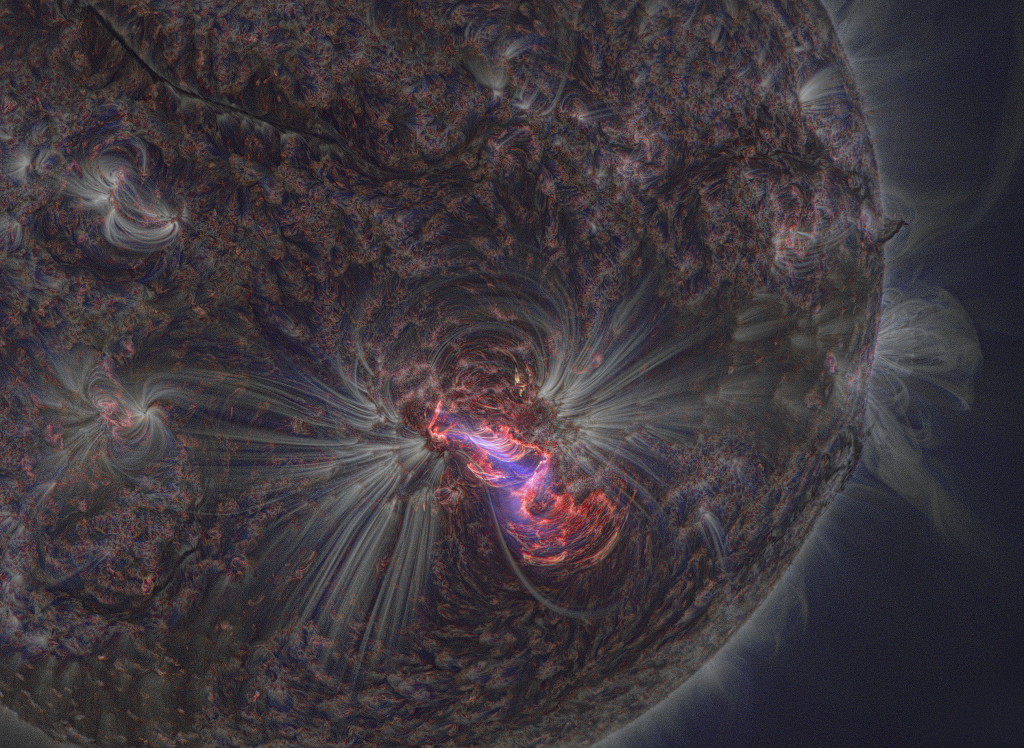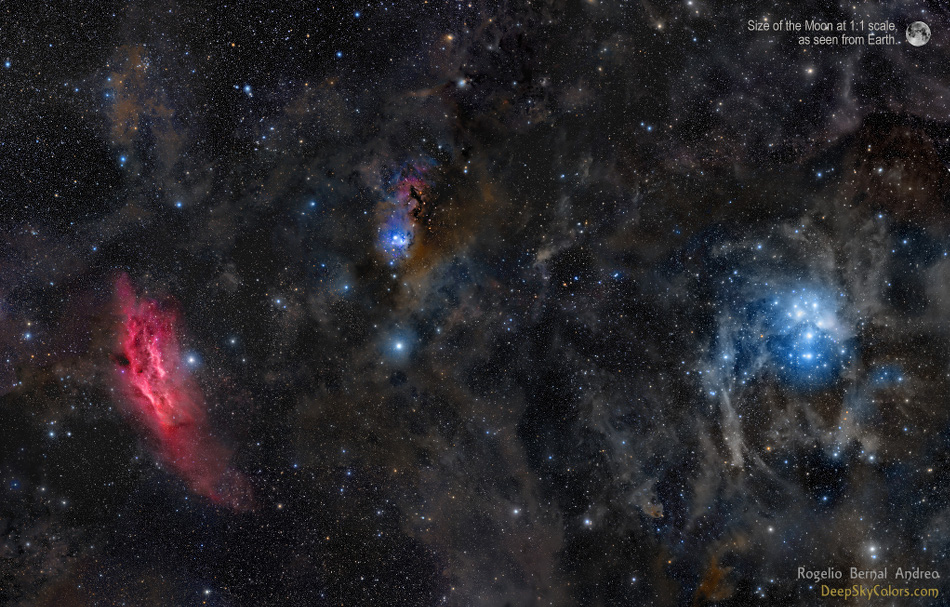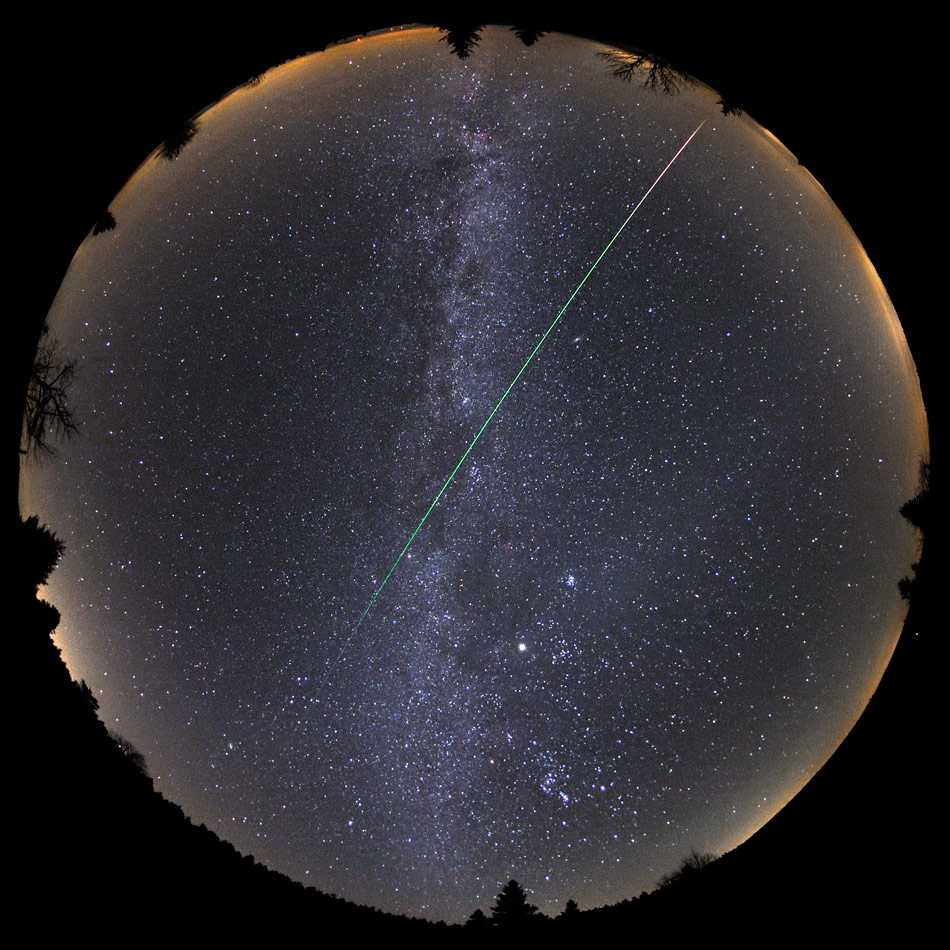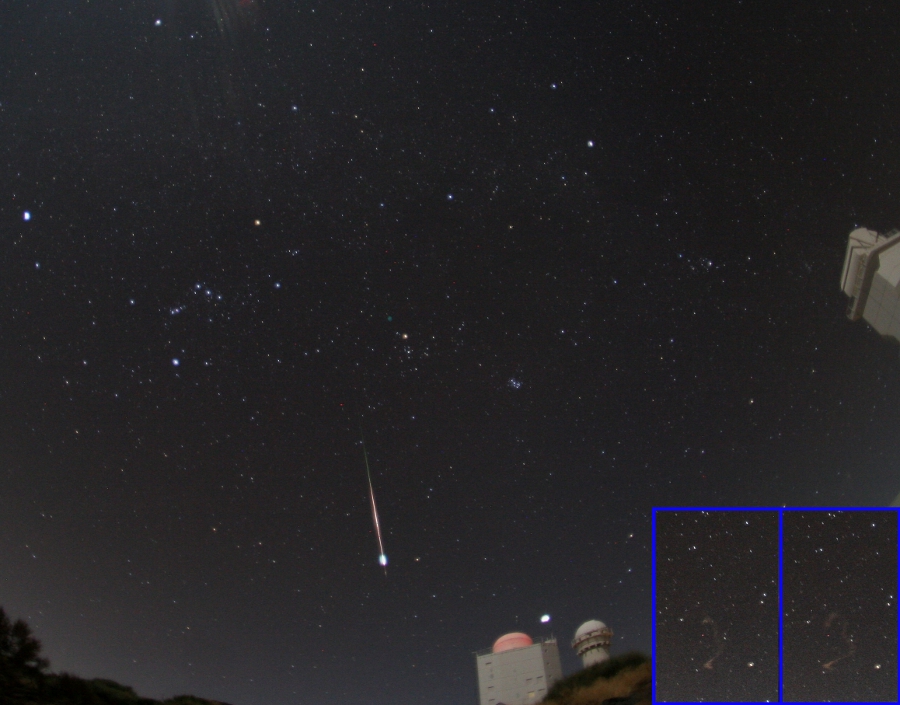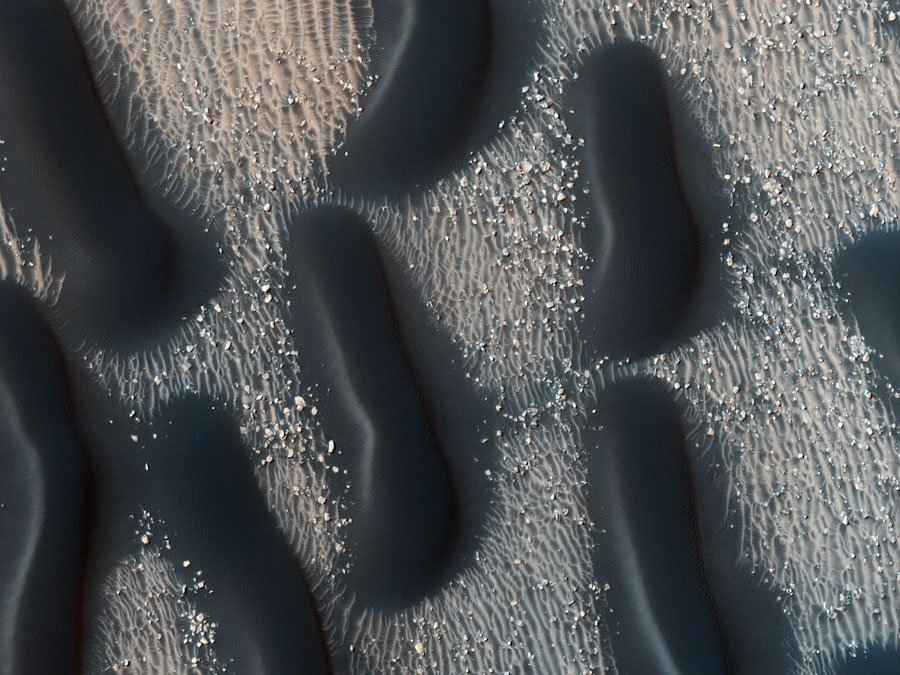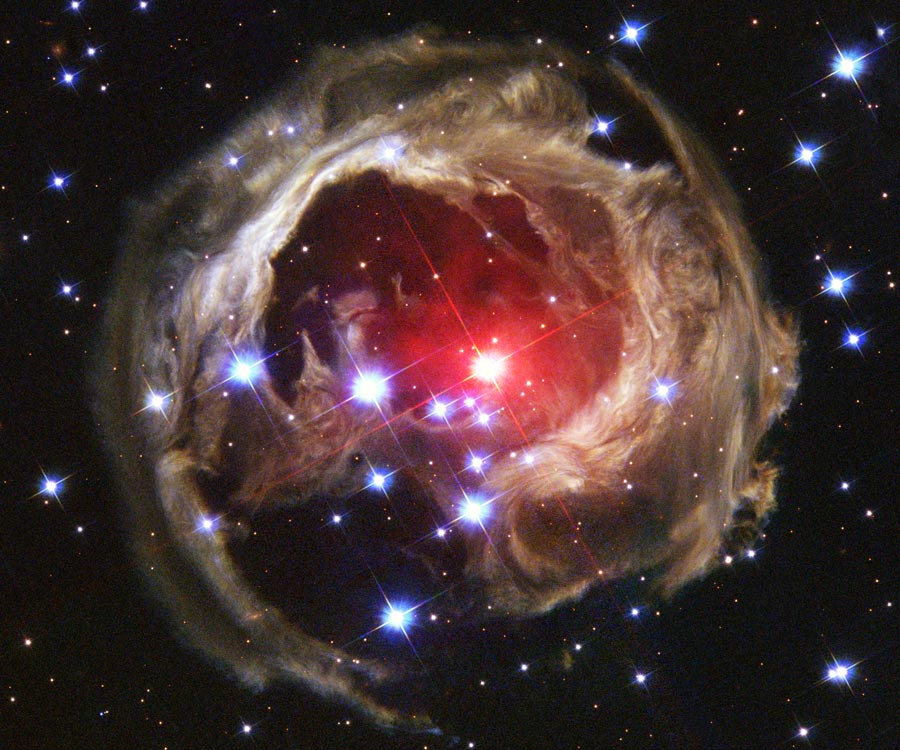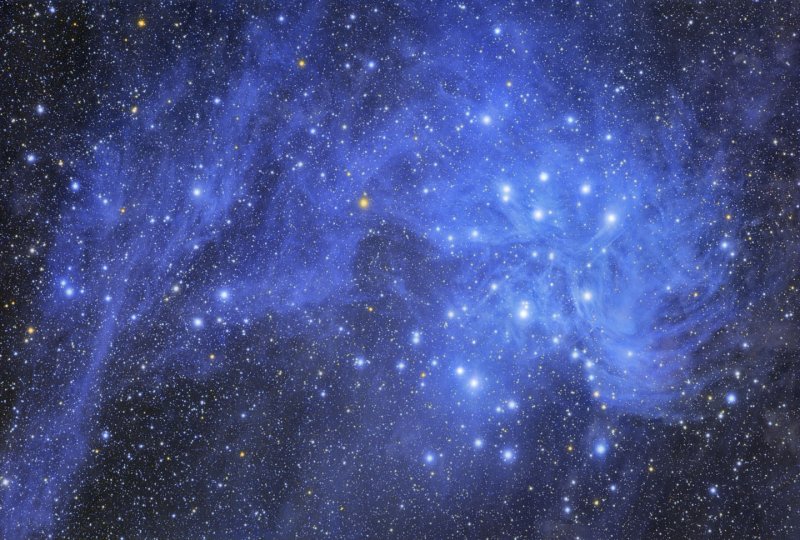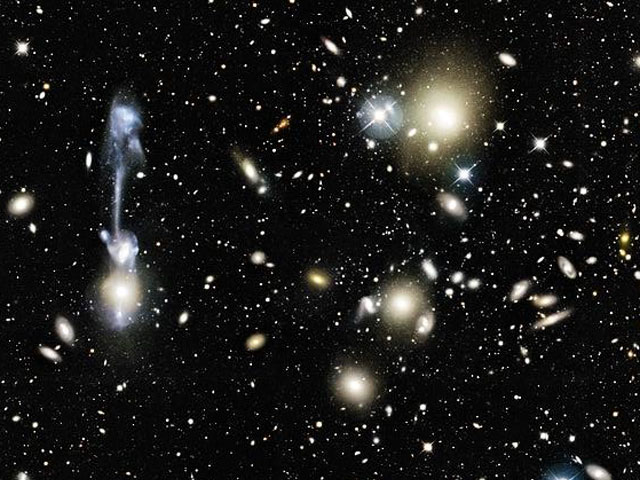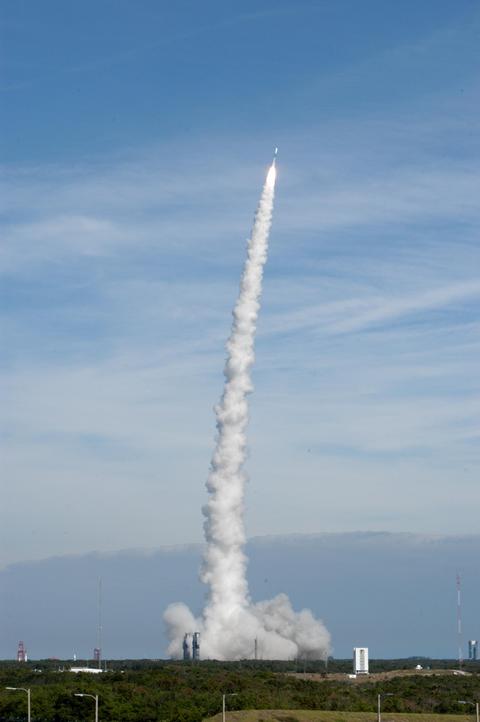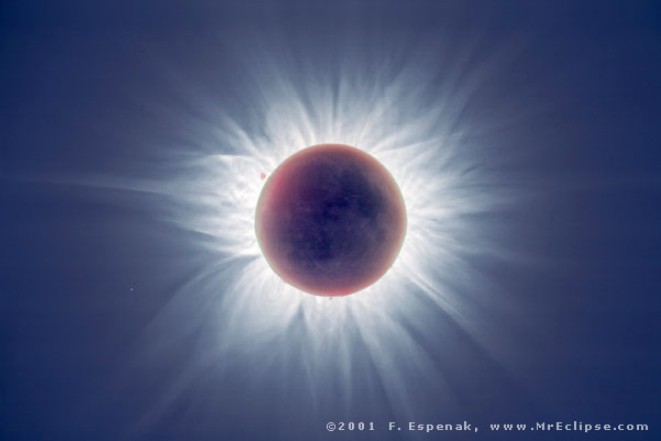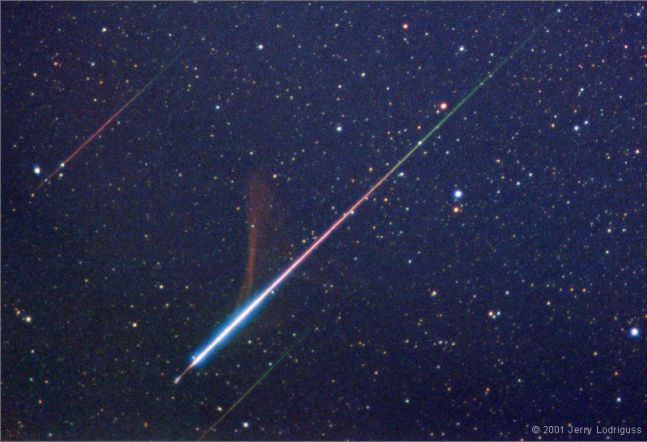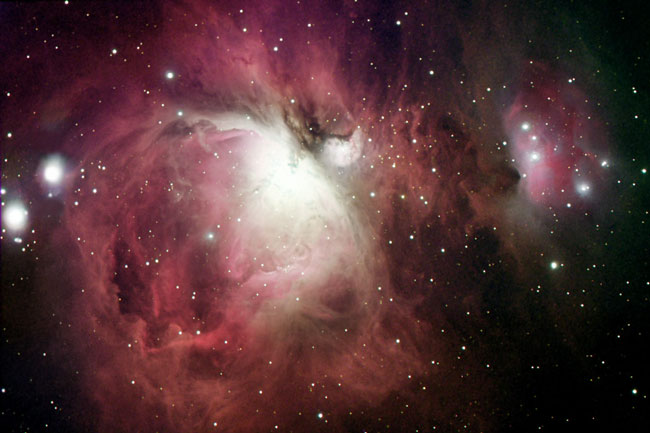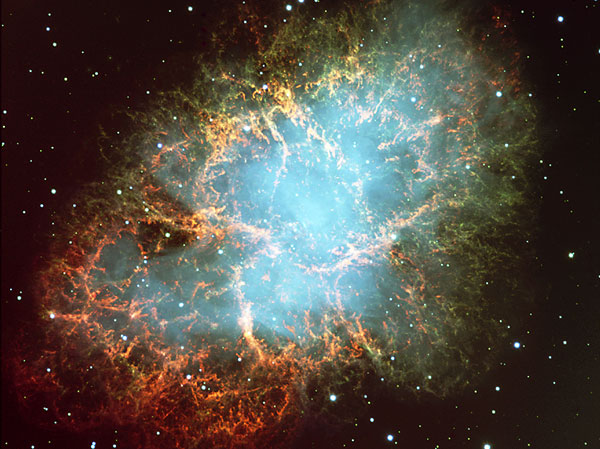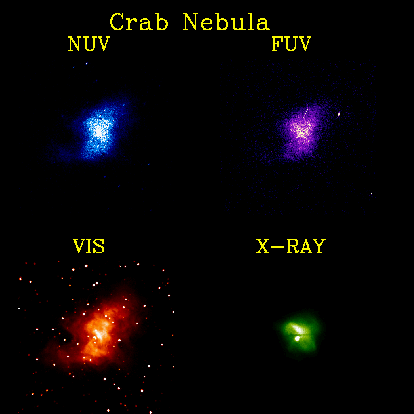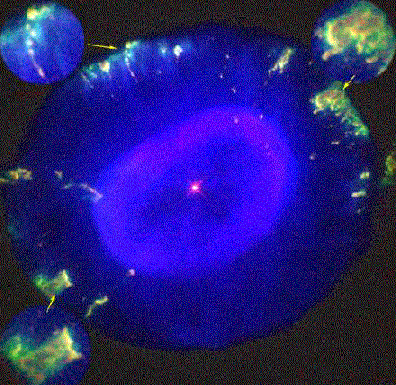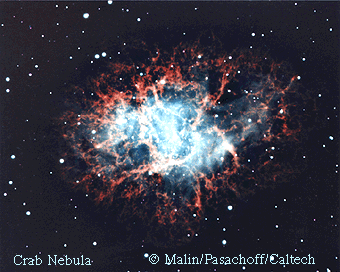| << Previous | Index | Next >> |
2014
2013 An astronomical trip from the California Nebula to the Pleiades star cluster would cover just over 12 degrees across planet Earth's night sky. That's equivalent to the angular extent of 25 Full Moons, as your telescope sweeps past the borders of the constellations Perseus and Taurus. This wide and deep mosaic image of the region explores the cosmic landscape's dusty nebulae and colors otherwise too faint for your eye to see. On the left, cataloged as NGC 1499, the California Nebula does have a familiar shape, though its coastline is actually over 60 light-years long and lies about 1,500 light-years away. The nebula's pronounced reddish glow is from hydrogen atoms ionized by luminous blue star Xi Persei seen just to its right. At the far right, the famous Pleiades star cluster is some 400 light-years distant and around 15 light-years across. Its spectacular blue color is due to the reflection of starlight by interstellar dust. In between are hot stars of the Perseus OB2 association and dusty, dark nebulae along the edge of the nearby, massive Perseus molecular cloud.
2012 A cosmic grain of sand left the long and colorful trail across this all-sky view. Its grazing impact with planet Earth's atmosphere began at 71 kilometers per second. With the Milky Way stretching from horizon to horizon, the scene was captured on the night of November 17 from the astronomically popular high plateau at Champ du Feu in Alsace, France. Of course, the earthgrazer meteor belongs to this month's Leonid meteor shower, produced as our fair planet annually sweeps through dust from the tail of periodic Comet Tempel-Tuttle. The shower's radiant point in the constellation Leo is very close to the eastern horizon, near the start of the trail at the lower left. Bright planet Jupiter is also easy to spot, immersed in a faint band of Zodiacal light just below and right of center. The image is part of a dramatic time-lapse video (vimeo here) that began only 7 minutes before the long leonid crossed the sky.
2011 Historically active, this year's Leonid meteor shower was diminished by bright moonlight. Still, faithful night sky watchers did see the shower peak on November 18 and even the glare of moonlight didn't come close to masking this brilliant fireball meteor. The colorful meteor trail and final flare was captured early that morning in western skies over the Canary Island Observatorio del Teide on Tenerife. Particles of dust swept up when planet Earth passes near the orbit of periodic comet Tempel-Tuttle, Leonid meteors typically enter the atmosphere at nearly 70 kilometers per second. Looking away from the Moon, the wide angle camera lens also recorded bright stars in the familiar constellations Orion and Taurus near picture center. Inset are two exposures of this fireball's persistent train. The consecutive train images follow the meteor's flash by several minutes as high altitude winds disperse the faint, smokey trail. The two large telescope buildings are the GREGOR telescope with reddish dome and the Vacuum Tower Telescope along the right edge of the frame, both sun watching telescopes.
2010 Was this image taken with a telescope or a microscope? Perhaps this clue will help: if the dark forms were bacteria, they would each span over football field across. What is actually being seen are large sand dunes on the floor of Proctor Crater on Mars. The above picture was taken by HiRISE camera on board the Mars Reconnaissance Orbiter (MRO), a robot spacecraft currently in orbit around Mars. The dark rippled dunes likely formed more recently than the lighter rock forms they appear to cover, and are thought to slowly shift in response to pervasive winds. The dunes arise from a complex relationship between the sandy surface and high winds on Mars. Similar dunes were first seen in Proctor Crater by Mariner 9 more than 35 years ago.
2009 What caused this outburst of V838 Mon? For reasons unknown, star V838 Mon's outer surface suddenly greatly expanded with the result that it became the brightest star in the entire Milky Way Galaxy in January 2002. Then, just as suddenly, it faded. A stellar flash like this has never been seen before -- supernovas and novas expel matter out into space. Although the V838 Mon flash appears to expel material into space, what is seen in the above image from the Hubble Space Telescope is actually an outwardly moving light echo of the bright flash. In a light echo, light from the flash is reflected by successively more distant rings in the complex array of ambient interstellar dust that already surrounded the star. V838 Mon lies about 20,000 light years away toward the constellation of the unicorn (Monoceros), while the light echo above spans about six light years in diameter.
2008 In this panorama of Earth and sky recorded on Thursday, November 13, the Full Moon rises along the eastern horizon at the far left. Of course, the Full Moon rises at sunset and that Thursday's setting Sun was also captured at the far right. In between, 17 digital images are stitched together to follow the horizon to the south in a lovely twilight portrait of the city of Lisbon, Portugal. The serene view takes in part of the longest bridge in Europe, the Vasco da Gama bridge, beneath the rising Moon and ends at the mouth of the Tagus River looking west toward the sunset and the Atlantic Ocean. The photographer's vantage point was Lisbon's 100 foot high Cristo Rei monument on the south bank of the Tagus, at the foot of the port city's other famous bridge, the Ponte 25 de Abril.
2007 Hurtling through a cosmic dust cloud a mere 400 light-years away, the lovely Pleiades or Seven Sisters star cluster is well-known for its striking blue reflection nebulae. This remarkable wide-field (3 degree) image of the region shows the famous star cluster at the right, while highlighting lesser known dusty reflection nebulae nearby, across an area that would span over 20 light-years. In this case, the sister stars and cosmic dust clouds are not related, they just happen to be passing through the same region of space. But astronomers using infrared detectors have recently found a dusty disk that really does belong to one young Pleiades star -- HD 23514. Surrounding HD 23514, the disk is estimated to be comparable in size to the terrestrial planet zone in our own solar system and likely represents the debris from the process of rocky planet formation.
2006 Please wait while one of the largest mobile machines in the world crosses the road. The machine pictured above is a bucket-wheel excavator used in modern surface mining. Machines like this have given humanity the ability to mine minerals and change the face of planet Earth in new and dramatic ways. Some open pit mines, for example, are visible from orbit. The largest excavators are over 200 meters long and 100 meters high, now dwarfing the huge NASA Crawler that transports space shuttles to the launch pads. Bucket-wheel excavators can dig a hole the length of a football field to over 25 meters deep in a single day. They may take a while to cross a road, though, with a top speed under one kilometer per hour.
2005 What is a guitar doing in a cluster of galaxies? Colliding. Clusters of galaxies are sometimes packed so tight that the galaxies that compose them collide. A prominent example occurs on the left of the above image of the rich cluster of galaxies Abell 1185. There at least two galaxies, cataloged as Arp 105 and dubbed The Guitar for their familiar appearance, are pulling each other apart gravitationally. Most of Abell 1185's hundreds of galaxies are elliptical galaxies, although spiral, lenticular, and irregular galaxies are all clearly evident. Many of the spots on the above image are fully galaxies themselves containing billions of stars, but some spots are foreground stars in our own Milky Way Galaxy. Recent observations of Abell 1185 have found unusual globular clusters of stars that appear to belong only to the galaxy cluster and not to any individual galaxy. Abell 1185 spans about one million light years and lies 400 million light years distant.
2004 Where do gamma ray bursts occur? To help find out, NASA launched the Swift satellite on Saturday, as pictured above. What Swift is designed to do better than any previous satellite is to quickly locate these enigmatic explosions in both sky position and distance. Once a gamma ray burst (GRB) is located, Swift itself will rotate to face it head-on and determine its distance directly. Swift locations will be immediately beamed down to Earth-based telescopes operating around the world and across the electromagnetic spectrum that are just waiting for a place on the sky to point. Subsequently collected GRB and afterglow information will help astronomers not only determine the nature of the initial explosions, but also the nature of the expanding shockwaves. Some Swift-located GRBs could turn out to be the most distant transient events ever detected, holding unique clues to the nature and rate of the very first wave of star formation in the early universe.
2003 This composite image was made from 22 separate pictures of the Moon and Sun all taken from Chisamba, Zambia during the total phase of the 2001 June 21 solar eclipse. The multiple exposures were digitally processed and combined to simultaneously show a wealth of detail which no single camera exposure or naked-eye observation could easily reveal. Most striking are the incredible flowing streamers of the Sun's outer atmosphere or solar corona, notoriously difficult to see except when the new Moon blocks the bright solar disk. Features on the darkened near side of the Moon can also be made out, illuminated by sunlight reflected from a full Earth. A giant solar prominence seems to hang just beyond the Moon's eastern (left) edge while about one diameter farther east of the eclipsed Sun is the relatively faint (4th magnitude) star 1 Geminorum. The still active Sun will be totally eclipsed by the Moon tomorrow, but the path of the total eclipse will mostly cross the relatively inaccessible continent of Antarctica.
2002
[img6="Credit & Copyright: Image: Blake Suddeth; Haiku "Leonids Indeed": Susan Ode"]http://apod.nasa.gov/apod/image/0211/Le ... uddeth.jpg[/img6]
Full of itself moon -
EVERYONE SHOULD LOOK AT ME.
What's 33 years?
And for those who need a story ... photographer Blake Suddeth took over a hundred digital pictures early Tuesday morning in order to capture this single, gorgeous 10 second exposure of a "Leonid of the Lake" meteor flashing by a very full of itself moon. The dreamlike foreground lake and fog are courtesy of Greenwood, South Carolina, USA.
EVERYONE SHOULD LOOK AT ME.
What's 33 years?
2001 Returning from orbit, space shuttles enter the atmosphere at about 8 kilometers per second as friction heats their protective ceramic tiles to over 1,400 degrees Celsius. By contrast, the bits of comet dust which became the Leonid meteors seen on November 18, were moving at 70 kilometers per second, completely vaporizing at altitudes of around 100 kilometers. In this single 5 minute time exposure, three Leonid meteors are shooting through skies above Spruce Knob, West Virginia, USA. Background stars are near the constellation Orion. The brightest meteor, a fireball, dramatically changes colors along its path and leaves a smokey persistant trail drifting in high-altitude winds. From that extremely dark site, at an elevation of 1,200 meters, astrophotographer Jerry Lodriguss reports, "We observed a [zenithal hourly rate] of about 3,600 at 10:30 UT and very high rates from 9:30 UT until well into the start of astronomical twilight at 10:50 UT. It was quite a spectacular storm, with bolides going off like flashbulbs, green and red fireballs and other fainter Leonids in all parts of the sky."
2000 The Great Nebula in Orion can be found just below and to the left of the easily identifiable belt of three stars in the popular constellation Orion. This fuzzy patch, visible to the unaided eye, contains one of the closest stellar nurseries, lying at a distance of about 1500 light years. The above picture highlights red light emitted by the nebula's hydrogen gas. Dark dust filaments punctuate regions of this glowing hydrogen gas and reflect light from the nebula's brightest stars. Recent observations of the Orion Nebula by the Hubble Space Telescope have located solar-system sized regions that are thought to be planet-forming circumstellar disks.
1999 The Crab Nebula, filled with mysterious filaments, is the result of a star that was seen to explode in 1054 AD. This spectacular supernova explosion was recorded by Chinese and (quite probably) Anasazi Indian astronomers. The filaments are mysterious because they appear to have less mass than expelled in the original supernova and higher speed than expected from a free explosion. In the above picture taken recently from a Very Large Telescope, the color indicates what is happening to the electrons in different parts of the Crab Nebula. Red indicates the electrons are recombining with protons to form neutral hydrogen, while blue indicates the electrons are whirling around the magnetic field of the inner nebula. In the nebula's very center lies a pulsar: a neutron star rotating, in this case, 30 times a second.
1998 This is the mess that is left when a star explodes. The Crab Nebula is so energetic that it glows in every kind of light known. Shown above are images of the Crab Nebula from visible light to the X-ray band. NUV stands for "near ultraviolet" light, FUV means "far ultraviolet" light, and VIS means visible light. In the center of the Crab Nebula lies the powerful Crab pulsar - a spinning neutron star with mass comparable to our Sun but with the diameter of only a small town. The pulsar expels particles and radiation in a beam that sweeps past the Earth 30 times a second. The supernova that created the Crab Nebula was seen by ancient Chinese astronomers and possibly even the Anasazi Indians -- in 1054 AD, perhaps glowing for a week as bright as the full moon. The Crab still presents mysteries today as the total mass of the nebula and pulsar appears much less than the mass of the original pre-supernova star!
1997 This panorama of the cratered lunar surface was constructed from images returned by the US Surveyor 6 lander. Surveyor 6 was not the first spacecraft to accomplish a soft landing on the Moon ... but it was the first to land and then lift off again! After touching down near the center of the Moon's nearside in November of 1967, NASA controllers commanded the spacecraft to hop. Briefly firing its rocket engine and lifting itself some 4 meters above the surface, the Surveyor moved about 2.5 meters to one side before setting down again. The hopping success of Surveyor 6 essentially marked the completion of the Surveyor series main mission - to determine if the lunar terrain was safe for the planned Apollo landings.
1996 Planetary nebulae are strange. First, they are gas clouds and have nothing to do with our Solar System's planets. Next, although hundreds of planetary nebulae have been catalogued and thousands surely exist in our Galaxy, aspects of the formation process are still debated. But now yet another mystery has come to light: what created the fast-moving gas clouds that appear around planetary nebula? Dubbed FLIERs for Fast Low-Ionization Emission Regions, these knots of dense gas appear to have been ejected from the central star before it cast off the planetary nebula. Currently, no model can account for either their formation or longevity. In the above false-color picture of NGC 7662, the Blue Snowball Planetary Nebula, the FLIERs are featured in the image inserts.
1995 The Crab Nebula resulted from a star that exploded - a supernova. The outer layers of the star were thrown violently into space, while the inner core collapsed to form a neutron star. This neutron star is visible to us today as a pulsar - a rotating star at the center of the nebula that emits visible flashes of light. The Crab Pulsar flashes about 30 times every second. Although the stellar explosion that caused the Crab Nebula was seen over 900 years ago, the nebula itself still expands and shines. How the nebula obtains the energy needed to shine was a mystery eventually solved by noting that this energy could be released by the slowing of the pulsar's rotation.
| << Previous | Index | Next >> |
